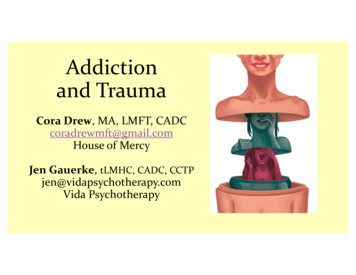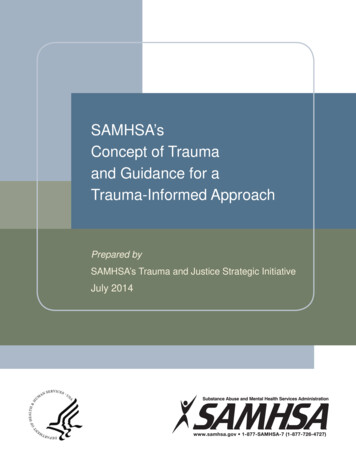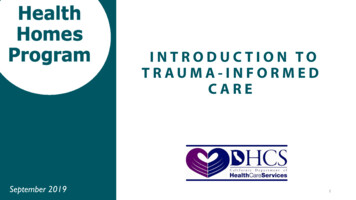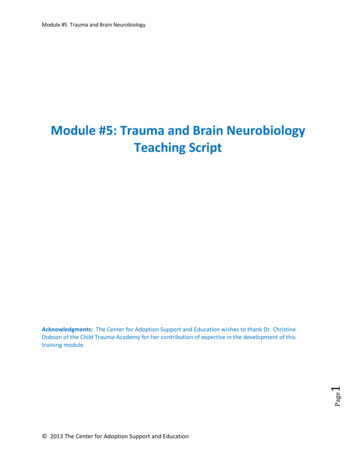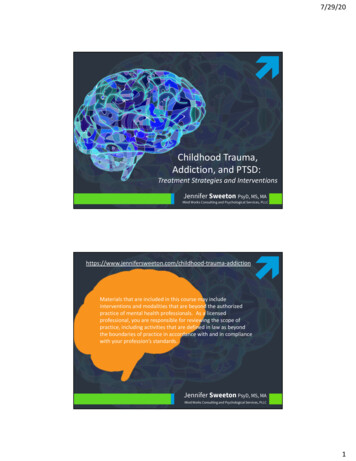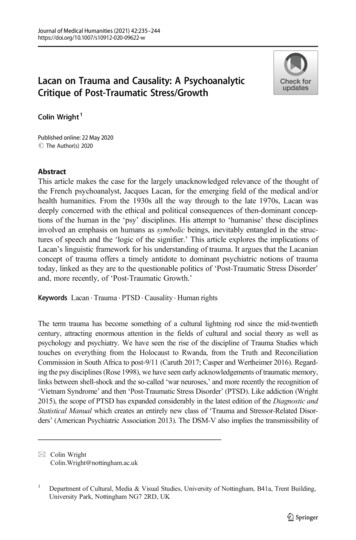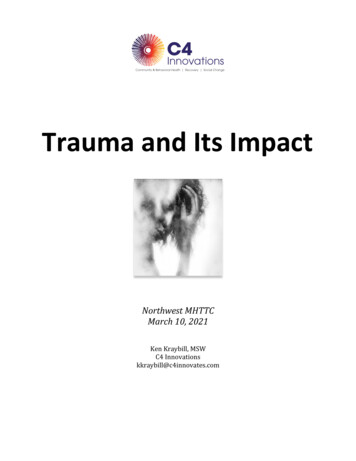
Transcription
Trauma and Its ImpactNorthwest MHTTCMarch 10, 2021Ken Kraybill, MSWC4 Innovationskkraybill@c4innovates.com
Trauma and Its ImpactSome people experience very few traumatic events in their lives. Others experience chronictraumatic stress that can potentially have a major impact on how people understandthemselves, the world, and others. People who have experienced multiple traumas do notrelate to the world in the same way as those who have not. They require services andresponses that are uniquely sensitive to their needs.What makes an experience traumatic? The experience involves a threat to one’s physical or emotional well-being. It is overwhelming. It results in intense feelings of fear and lack of control. It leaves people feeling helpless. It changes the way a person understands themselves, the world and others.Trauma-awarenessWe know people can and do recover from trauma, and we want to provide services andenvironments that support healing. To be a “trauma-informed” provider is to root yourcare in an understanding of the impact of trauma and the specific needs of traumasurvivors. We want to avoid causing additional harm to those we serve.Understanding trauma and its impactUnderstanding traumatic stress and its impact is essential. Trauma survivors, particularlythose who have experienced early childhood trauma/developmental trauma, often developa set of survival skills that help them to manage past trauma. These survival strategies (likesubstance misuse, withdrawal, aggression, self-harm, etc.) make sense given what peoplehave experienced. But they can be confusing and frustrating to others and often get in theway of current goals.Without an understanding of trauma, providers may view those they serve in negativeways. Providers might describe behaviors as “manipulative,” “oppositional,” or“unmotivated.” Yet these behaviors may be better understood as strategies to manageoverwhelming feelings and situations. Trauma-informed training can help providersunderstand these responses and offer trauma-sensitive care.Adapted from Trauma-Informed Care 101, Homelessness Resource Center for Social .aspx?id 46857&g ComResPosts&t 4232
Types of Trauma and ViolenceTraumatic events impact individuals, families, and communities. They can include:Sexual Abuse or Assault Sexual abuse or assault includes unwanted or coercive sexual contact,exposure to age-inappropriate sexual material or environments, and sexual exploitation. TheDepartment of Justice’s (DOJ) https://www.justice.gov/ovw defines sexual assault as “any type ofsexual contact or behavior that occurs without the explicit consent of the recipient.”Physical Abuse or Assault Physical abuse or assault is defined as the actual or attemptedinfliction of physical pain (with or without the use of an object or weapon), including the use ofsevere corporeal punishment. Federal law defines child abuse as any act, or failure to act, whichresults in death, serious physical or emotional harm, sexual abuse, or exploitation of a child.Emotional Abuse or Psychological Maltreatment Emotional abuse and psychologicalmaltreatment are considered acts of commission (other than physical or sexual abuse) against anindividual. These kinds of acts, which include verbal abuse, emotional abuse, and excessivedemands or expectations, may cause an individual to experience conduct, cognitive, affective, orother mental disturbances. These acts also include acts of omission against a minor such asemotional neglect or intentional social deprivation, which cause, or could cause, a child toexperience conduct, cognitive, affective, or other mental disturbances.Neglect Neglect is the most common form of abuse reported to child welfare authorities. However,it does not occur only with children. It can also happen when a primary caregiver fails to give anadult the care they need, even though the caregiver can afford to, or has the help to do so. Neglectalso includes the failure to provide an individual with basic needs such as food, clothing, or shelter.It can also mean not providing medical or mental health treatment or prescribed medicines. Neglectalso includes exposing someone to dangerous environments, abandoning a person, or expellingthem from home.Serious Accident, Illness, or Medical Procedure Trauma can occur when a person experiencesan unintentional injury or accident, a physical illness, or medical procedures that are extremelypainful and/or life threatening.Victim or Witness to Domestic Violence According to DOJ’s Office of Violence Against Women,domestic violence is defined as: “a pattern of abusive behavior in any relationship that is used byone partner to gain or maintain power and control over another intimate partner. Domesticviolence can be physical, sexual, emotional, economic, or psychological actions or threats of actionsthat influence another person. This includes any behaviors that intimidate, manipulate, humiliate,isolate, frighten, terrorize, coerce, threaten, blame, hurt, injure, or wound someone.” Domesticviolence includes violence and abuse by current or former intimate partners, parents, children,siblings, and other relatives.Victim or Witness to Community Violence Extreme violence in the community, includingexposure to gang-related violence, interracial violence, police and citizen altercations, and otherforms of destructive individual and group violence is a recognized form of trauma.Racial trauma or race-based traumatic stress is the cumulative effects of racism on an individual’smental and physical health.Historical Trauma Historical trauma is a form of trauma that impacts entire communities. Itrefers to the cumulative emotional and psychological wounding, as a result of group traumatic3
experiences, that is transmitted across generations within a community. Unresolved grief and angeroften accompany this trauma and contribute to physical and behavioral health disorders. This typeof trauma is often associated with racial and ethnic population groups in the United States whohave suffered major intergenerational losses and assaults on their culture and well-being.School Violence School violence is described as violence that occurs in a school setting andincludes, but is not limited to, school shootings, bullying, interpersonal violence among classmates,and student suicide. Youth violence is a serious problem that can have lasting harmful effects onvictims and their families, friends, and communitiesBullying Bullying is unwanted, aggressive behavior among school-aged children that involves areal or perceived power imbalance. The behavior is repeated, or has the potential to be repeated,over time. Both kids who are bullied and who bully others may experience serious, lastingproblems. Trauma can be a consequence of bullying, which can lead to mental health issues,substance use, and suicide, particularly if there is a prior history of depression or delinquency.Natural or Manmade Disasters Trauma can result from a major accident or disaster that is anunintentional result of a manmade or natural event. Disasters can occur naturally (such astornadoes, hurricanes, earthquakes, floods, wildfires, mudslides, or drought) or be human-caused(such as mass shootings, chemical spills, or terrorist attacks).Forced Displacement Forced displacement is a traumatic event that occurs when people facepolitical persecution and are forced to relocate to a new home (as an immigrant or through politicalasylum) or become a refugee.War, Terrorism, or Political Violence Exposure to acts of war-, terrorism-, or political-relatedviolence such as bombing, shooting, and looting can cause trauma in an individual.Military Trauma Military trauma refers to both the impact of deployment and trauma-relatedstress on people who are deployed and their families. Significant numbers of returning service menand women experience mental and/or substance use disorders associated with military traumaand/or military sexual trauma.Victim or Witness to Extreme Personal or Interpersonal Violence. This type of trauma includesextreme violence by or between individuals including exposure to homicide, suicide, and otherextreme events.Traumatic Grief or Separation Traumatic grief and/or separation may include the death of aparent, primary caretaker, or sibling; abrupt and/or unexpected, accidental, or premature death orhomicide of a close friend, family member, or other close relative; abrupt, unexplained and/orindefinite separation from a parent, primary caretaker, or sibling due to uncontrollablecircumstances.System-Induced Trauma and Re-traumatization Many systems that are designed to helpindividuals and families can actually cause trauma. For example, in child welfare systems, abruptremoval from the home, foster placement, sibling separation, or multiple placements in a shortamount of time can retraumatize children. In mental health systems, the use of seclusion andrestraint on previously traumatized individuals can revive memories of trauma. Further, invasivemedical procedures on a trauma victim can re-induce traumatic reactions.Adapted from: https://www.samhsa.gov/trauma-violence/types4
Complex Post Traumatic Stress Disorder (C-PTSD)Complex Post Traumatic Stress Disorder (C-PTSD) is a condition that results from chronic or longterm exposure to trauma over which a person has little or no control and from which there is littleor no hope of escape, such as in cases of: Childhood/domestic emotional, physical or sexual abuse Repeated violations of personal boundaries Long-term objectification Exposure to gaslighting/mental abuse and false accusations Long-term exposure to inconsistent, push-pull, splitting or alternating raging and hooveringbehaviors Long-term taking care of mentally ill or chronically sick family members Entrapment, kidnapping Slavery or enforced labor Long term imprisonment and torture Long term exposure to crisis conditionsWhen people have been trapped in a situation over which they had little or no control at thebeginning, middle or end, they can carry an intense sense of dread even after that situation isremoved. This is because they know how bad things can possibly be. And they know that it couldpossibly happen again. And they know that if it ever does happen again, it might be worse thanbefore.The degree of C-PTSD trauma cannot be defined purely in terms of the trauma that a person hasexperienced. It is important to understand that each person is different and has a differenttolerance level to trauma. Therefore, what one person may be able to shake off, another person maynot. Therefore, more or less exposure to trauma does not necessarily make the C-PTSD any more orless severe.People experiencing symptoms of C-PTSD may "stuff" or suppress their emotional reaction totraumatic events without resolution either because they believe each event by itself doesn't seemlike such a big deal or because they see no satisfactory resolution opportunity available to them.This suppression of "emotional baggage" can continue for a long time either until a "last straw"event occurs, or a safer emotional environment emerges, and the damn begins to break.The "Complex" in Complex Post Traumatic Disorder describes how one layer after another oftrauma can interact with one another. Sometimes, it is mistakenly assumed that the most recenttraumatic event in a person's life is the one that brought them to their knees. However, justaddressing that single most-recent event may possibly be an invalidating experience for the C-PTSDsufferer. Therefore, it is important to recognize that those who suffer from C-PTSD may beexperiencing feelings from all their traumatic exposure, even as they try to address the most recenttraumatic event.This is what differentiates C-PTSD from the classic PTSD diagnosis – which typically describes anemotional response to a single or to a discrete number of traumatic events.5
Difference between C-PTSD & PTSDAlthough similar, Complex Post Traumatic Stress Disorder (C-PTSD) differs from the morecommonly understood and diagnosed condition Post Traumatic Stress Disorder (PTSD) in causesand symptoms. C-PTSD results more from chronic repetitive stress from which there is little chanceof escape. PTSD can result from single events, or short-term exposure to extreme stress or trauma.Therefore, a soldier returning from intense battle may be likely to show PTSD symptoms, but akidnapped prisoner of war who was held for several years may show additional symptoms of CPTSD. Similarly, a child who witnesses a friend's death in an accident may exhibit some symptomsof PTSD but a child who grows up in an abusive home may exhibit the additional C-PTSDcharacteristics shown below.C-PTSD - What it feels likePeople experiencing C-PTSD may feel uncentered and shaky, as if they are likely to have anembarrassing emotional breakdown or burst into tears at any moment. They may feel unloved, orthat nothing they can accomplish is ever going to be "good enough" for others.Sometimes people living with C-PTSD may feel compelled to get away from others and be bythemselves, so that no-one will witness what may come next. They may feel afraid to form closefriendships to prevent possible loss should another catastrophe strike.People may feel that everything is just about to go "out the window" and that they will not be ableto handle even the simplest task. They may be too distracted by what is going on at home to focuson being successful at school or in the workplace.C-PTSD characteristicsHow it can manifest in a person over time: Rage turned inward – eating disorders, depression, alcohol/other substance misuse,truancy, dropping out, promiscuity, co-dependence doormat syndrome (choosing poorpartners, trying to please someone who can never be pleased, trying to resolve the primalrelationship) Rage turned outward – theft, destruction of property, violence, becoming a control freak Other – learned hyper vigilance, clouded perception or blinders about others (especiallyromantic partners), seeks positions of power and/or control, choosing occupations orrecreational outlets which may put oneself in physical danger, or choosing to become a"fixer" – therapist, mediator, etc. Avoidance – the practice of withdrawing from relationships with other people as adefensive measure to reduce the risk of rejection, accountability, criticism or exposure Blaming – the practice of identifying a person or people responsible for creating a problem,rather than identifying ways of dealing with the problem Catastrophizing – the habit of automatically assuming a "worst case scenario" andinappropriately characterizing minor or moderate problems or issues as catastrophicevents “Control-Me” syndrome – this describes a tendency to foster relationships with people whohave controlling, narcissistic, antisocial or "acting-out" behaviors Denial – believing or imagining that some painful or traumatic circumstance, event ormemory does not exist or did not happen Dependency – an inappropriate and chronic reliance by an adult individual on anotherindividual for their health, subsistence, decision making or personal and emotional wellbeing Depression – when you feel sadder than your circumstances dictate, for longer than yourcircumstances last, but still can't seem to break out of it Escape to fantasy – taking an imaginary excursion to a happier, more hopeful place6
Fear of abandonment – an irrational belief that one is imminent danger of being personallyrejected, discarded or replacedRelationship hypervigilance – maintaining an unhealthy level of interest in the behaviors,comments, thoughts and interests of others.Identity disturbance – a psychological term used to describe a distorted or inconsistentself-viewLearned helplessness – when a person begins to believe that they have no control over asituation, even when they doLow self-esteem – a common name for a negatively-distorted self-view which isinconsistent with realityPanic attacks – short intense episodes of fear or anxiety, often accompanied by physicalsymptoms, such as hyperventilating, shaking, sweating and chillsPerfectionism – the maladaptive practice of holding oneself or others to an unrealistic,unattainable or unsustainable standard of organization, order, or accomplishment in oneparticular area of living, while sometimes neglecting common standards of organization,order or accomplishment in other areas of livingSelective memory and selective amnesia – the use of memory, or a lack of memory, whichis selective to the point of reinforcing a bias, belief or desired outcomeSelf-loathing – an extreme hatred of one's own self, actions or one's ethnic or demographicbackgroundTunnel vision – the habit or tendency to only see or focus on a single priority whileneglecting or ignoring other important prioritiesC-PTSD causesC-PTSD is caused by a prolonged or sustained exposure to emotional trauma or abuse from whichno short-term means of escape is available or apparent to the victim. The precise neurologicalimpact that exists in C-PTSD victims is not well understood.How providers can helpLittle has been done in clinical studies of treatment of C-PTSD. However, in general the following isrecommended: Removal of and protection from the source of the trauma and/or abuse Acknowledgement of the trauma as real, important and undeserved Acknowledge that the trauma came from something that was stronger than the victim andtherefore could not be avoided Acknowledgement of the "complex" nature of C-PTSD – that responses to earlier traumasmay have led to decisions that brought on additional, undeserved trauma Acknowledgement that recovery from the trauma is not trivial and will require significanttime and effort Separation of residual problems into those that the individual can resolve (such as personalimprovement goals) and those that the person cannot resolve (such as the behavior of adisordered family member) Mourning for what has been lost and cannot be recovered Identification of what has been lost and can be recovered Program of recovery with focus on what can be improved in an individual's life that is undertheir own control Placement in a supportive environment where the victim can discover they are not aloneand can receive validation for their successes and support through their struggles. As necessary, personal therapy to promote self-discovery. As required, prescription of antidepressant medications.Adapted from mplex-post-traumatic-stressdisorder-c-ptsd7
Ways our services can re-traumatizeLack of privacyUnwanted physical touch (even when well-intended)Personal questions that may be embarrassing/distressingExpert-recipient vs. partnering approachOnly one right wayUnresolved trauma that’s transmittedInstitutional inequitiesStaff bias – race, ethnicity, gender, sexual identity, classEither/or thinkingRigid policies and proceduresOtherAdapted from SAMHSA-HRSA Center for Integrated Health SolutionsHow trauma can affect people’sengagement in servicesAvoidance due to fear of not being seen, heard, takenseriously, believedFear of placing trust in others, being controlled,exploited, abandonedMore comfortable with transactional relationshipsDifficulty keeping appointments, following up onreferrals, following through with plans (fear,avoidance, impaired memory, poor decision-making)OtherAdapted from SAMHSA-HRSA Center for Integrated Health Solutions8
Preventing Adverse Childhood ExperiencesWhat are adverse childhood experiences?Adverse childhood experiences, or ACEs, are potentially traumatic events that occur inchildhood (0-17 years). For example: experiencing violence, abuse, or neglectwitnessing violence in the home or communityhaving a family member attempt or die by suicideAlso included are aspects of the child’s environment that can undermine their sense ofsafety, stability, and bonding such as growing up in a household with: substance misusemental health problemsinstability due to parental separation or household members being in jail or prisonACEs are linked to chronic health problems, mental illness, and substance misuse inadulthood. ACEs can also negatively impact education and job opportunities. However,ACEs can be prevented.How big is the problem?ACEs are common. About 61% of adults surveyed across 25 states reported that they hadexperienced at least one type of ACE, and nearly 1 in 6 reported they had experienced fouror more types of ACEs.Preventing ACEs could potentially reduce a large number of health conditions. Forexample, up to 1.9 million cases of heart disease and 21 million cases of depression couldhave been potentially avoided by preventing ACEs.Some children are at greater risk than others. Women and several racial/ethnicminority groups were at greater risk for having experienced 4 or more types of ACEs.ACEs are costly. The economic and social costs to families, communities, and society totalshundreds of billions of dollars each year.What are the consequences?ACEs can have lasting, negative effects on health, well-being, and opportunity. Theseexperiences can increase the risks of injury, sexually transmitted infections, maternal andchild health problems, teen pregnancy, involvement in sex trafficking, and a wide range of9
chronic diseases and leading causes of death such as cancer, diabetes, heart disease, andsuicide.ACEs and associated conditions, such as living in under-resourced or racially segregatedneighborhoods, frequently moving, and experiencing food insecurity, can cause toxic stress(extended or prolonged stress). Toxic stress from ACEs can change brain development andaffect such things as attention, decision-making, learning, and response to stress.Children growing up with toxic stress may have difficulty forming healthy and stablerelationships. They may also have unstable work histories as adults and struggle withfinances, jobs, and depression throughout life. These effects can also be passed on to theirown children. Some children may face further exposure to toxic stress from historical andongoing traumas due to systemic racism or the impacts of poverty resulting from limitededucational and economic opportunities.How can we prevent adverse childhood experiences?ACEs are preventable. Creating and sustaining safe, stable, nurturing relationships andenvironments for all children and families can prevent ACEs and help all children reachtheir full potential. CDC has produced a resource, Preventing Adverse ChildhoodExperiences (ACEs): Leveraging the Best Available Evidence to help states andcommunities take advantage of the best available evidence to prevent ACEs. It features sixstrategies from the CDC Technical Packages to Prevent es/fastfact.html10
Signs of Secondary Traumatic StressSigns of secondary stress can appear in the emotional, spiritual, interpersonal, and physicalareas of one’s life. Consider whether you are experiencing any of the warning signals belowas a result of your work. You might also ask people close to you for their observations.Sometimes others can see us more clearly than we can see ourselves.Social withdrawalLow energy, fatigueFeelings of being easily overwhelmedPessimistic or cynical outlook on lifeIntrusive work-related thoughts or dreamsDifficulty keeping appropriate relationship boundariesDifficulty setting limits, saying “no”Depressed moodLack of motivationIncreased worry and anxietyEmotional numbnessFeelings that no one understands (or would be able to)Loss of interest in sexual activityVague physical aches, painMaking poor judgments and decisionsFeelings of loss of controlIncreased sense of danger or not feeling safeFinding your mind wandering at workDifficulty making decisionsSense of disconnection from loved onesIncreased feelings of suspiciousnessFeeling “adrift” spirituallyAccident-pronenessInvolvement in “risky” activities (e.g. drugs, alcohol, sexual behaviors)Increased irritability, agitationFeeling “on edge” much of the timeFeelings of despairWanting to escape, “run away from it all”Increased “sick days” from workViolating ethical standardsReduced work productivity, doing the “bare minimum”Decrease in respect for others, increase in blamingIncrease in obsessive thoughts and/or compulsive behaviorsDecreased interest in “self-care”Adapted from Saakvitne, Pearlman, and Traumatic Stress Institute Staff, Transforming the Pain: AWorkbook on Vicarious Traumatization, 1996.11
Selected Resources: Trauma and RecoveryACES Connection Resources Center ssuk, E.L., Olivet, JO, Winn, LP, & Nichols, K. (2014). Safety in Support: An Interactive eBook onTrauma-Informed Care. Available from the ibooks library.C4 Innovations: The TICOMETER , a psychometrically-validated instrument that measures thedegree to which an organization is engaged in trauma-informed s for Disease Control and ces/index.htmlChildhood Trauma: Changing Minds https://changingmindsnow.org/. Includes videos:Herman, J. (1992). Trauma and recovery. New York: Basic Books.Hopper, E. K., Bassuk, E. L., & Olivet, J. (2010). Shelter from the storm: Trauma-informed care inhomelessness services settings. The Open Health Services and Policy Journal, 3, 80-100.National Child Traumatic Stress Network www.nctsn.orgNational Council for Behavioral Health. Trauma-Informed Behavioral Health Care Trauma-InformedCare Organizational Self-Assessment s H, Davis R, Williams M. (2015). Adverse Community Experiences and Resilience: AFramework for Addressing and Preventing Community Trauma. Prevention Institute, Oakland, nces%20and%20Resilience.pdfSubstance Abuse and Mental Health Services Administration. Trauma-Informed Care in BehavioralHealth Services. Treatment Improvement Protocol (TIP) Series 57. HHS Publication No. (SMA) 134801. Rockville, MD: Substance Abuse and Mental Health Services Administration, 2014.SAMHSA: A Guide to GPRA Data Collection Using Trauma-informed Interviewing Skills, auma-InformedInterviewingManual-508.pdfSAMHSA National Center for Trauma-Informed Care and Alternatives to Seclusion and Restrainthttp://www.samhsa.gov/ncticStep Inside the Circle https://vimeo.com/398088783?ref fbshare&fbclid 4ZDhPoIbhYoThe Trauma Center at Justice Resource Institute http://www.traumacenter.orgThrough a Darker Lens: The Trauma of Racism in Communities of dfvan der Kolk, Bessel. (2014). The Body Keeps the Score: Brain, Mind, and Body in the Healing ofTrauma. New York: Viking12
Selected Online Videos: Trauma and RecoveryWhat is trauma-informed care? https://youtu.be/fWken5DsJcwEmpathy: The Human Connection to Patient Care https://youtu.be/cDDWvj q-o8Changing Minds Now https://changingmindsnow.org/healing“Chad” https://www.youtube.com/watch?v sFH6GR0ASKg“Unique” https://youtu.be/NRIECTLFhkMToxic stress derails healthy development https://youtu.be/rVwFkcOZHJwTrauma and the Brain https://youtu.be/ZLF SEy6sdcEmotional Regulation Techniques for Anxiety, Panic Attacks, Anger and Depression (JasonHalliwell) https://youtu.be/l6rrcqoKniQFather and Toddler Having Conversation https://youtu.be/Yn8j4XRxSckWhat Trauma Taught Me About Resilience (Charles Hunt)https://www.youtube.com/watch?v 3qELiw 1DdgImportant Facts about Resilience: A Consideration of Research Findings about Resilienceand Implications for Assessment and s/facts resilience.pdfAttachment and Resilience – The Power of One (Dr. Erica Liu Wollin)https://www.youtube.com/watch?v C-ZIUtJr8nESee No Stranger (Valery Kaur) https://youtu.be/QKMEqF0OVxs13
Complex Post Traumatic Stress Disorder (C-PTSD) Complex Post Traumatic Stress Disorder (C-PTSD) is a condition that results from chronic or long-term exposure to trauma over which a person has little or no control and from which there is little or no hope of escape, such as in cases of: Childhood/domestic emotional, physical or sexual abuse




